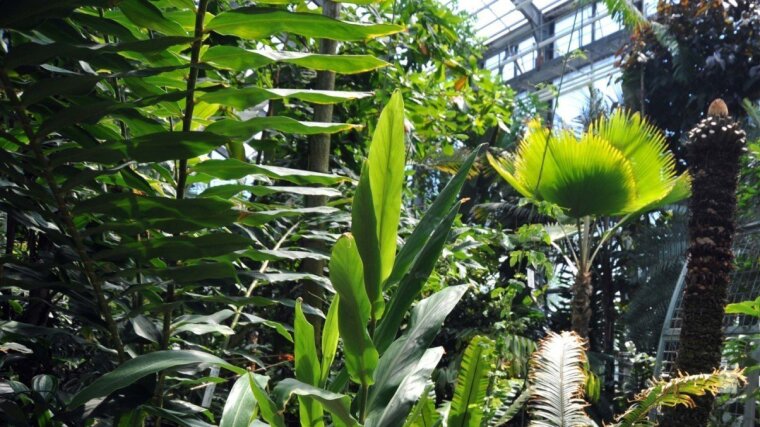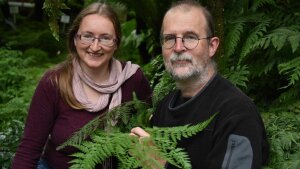
The result of a mammoth project: As part of the »One Thousand Plant Transcriptome Initiative«, all active genes of over 1,000 plants have been analysed with unprecedented accuracy over a period of nine years. The gigantic set of data can now be used to identify crucial stages of development in the plants’ continuous evolution over more than a billion years.
How did terrestrial plants manage to leave their original habitat—the water—and grow ever taller on land, despite the Earth’s gravity, and eventually produce flowers, seeds, and fruit? In order to answer such questions, around 200 scientists from more than 130 international research institutions have used immense computing technology to analyse all active genes—the transcriptome—of more than 1,000 green algae, mosses, clubmosses, ferns, gymnosperms, and flowering plants. They have arranged the genes and gene families into phylogenetic trees, revealed family relationships within the plant kingdom, and published their results in the journal »Nature«. A research team from from the Friedrich Schiller University Jena is among the authors.
The duplication of genetic material has played an important role in the emergence of plant diversity and the development of new properties. In the study, the geneticists Prof. Dr Günter Theißen and Dr Lydia Gramzow from the University of Jena examined the point of emergence and duplication of certain genes that are responsible for the development of flowers. These »MADS box genes« are found in all plant families, albeit in different frequencies. »The most primitive ancestors of modern- day plants were aquatic green algae,« explains Prof. Theißen. »They did not have any flowers or seeds and only a very small amount of MADS box genes«. Over the course of time, these ancestors have evolved into today’s terrestrial plants, including mosses, ferns and seed plants. The growing diversity of plant species has also led to an increase in the number and variety of MADS box genes. As MADS box genes control important processes in the development of plants, there is a direct correlation between the number and diversity of these genes and the complexity and diversity of plant structures.
Expansive gene duplication
It has long been known that modern-day plants have different amounts of MADS box genes in their genetic material. While simple mosses or club mosses have fewer than 50 copies on average, 50 to 300 different MADS box genes can be found in the genome of more developed seed plants. »One might assume that gene duplication is simply a result of the evolution of plants towards higher complexity,« says Dr Lydia Gramzow. However, the researcher examined almost 30,000 sequences during the latest study and was able to refute this assumption. »We have found the existence of MADS box genes to be the result of separate gene duplications,« says Gramzow. As reflected by the phylogenetic tree created by the researchers in Jena, MADS box genes (e.g. in ferns and seed plants) have multiplied and developed separately. »Both groups of plants have a common ancestor,« explains Prof. Theißen. From this, modern-day ferns have evolved along one line and seed plants have evolved along another. »MADS box genes have duplicated independently and with differing degrees of frequency along both lines. We suspect there were four different genes present in the last common ancestor of modern-day ferns and seed plants around 380 million years ago«.
Dr Lydia Gramzow and Prof. Dr Günter Theißen from the Matthias Schleiden Institute at the Friedrich Schiller University are part of the international research consortium that has examined the evolution of plant diversity more extensively than ever before.
Image: Jan-Peter Kasper (University of Jena)From their results, the geneticists conclude that similar processes may have also occurred in other gene families. »This reveals that evolution is not necessarily a one-dimensional and linear process; the same stage of evolutionary complexity is sometimesreached in different ways,« concludes Prof. Theißen.
Less is sometimes more
The study also shows that evolution does not necessarily result in more complex forms of life. »Reduction clearly proves to be an evolutionary advantage at times—this phenomenon is very common in many parasites,« says Theißen. The genetic data that has now been published proves that all modern- day bryophytes are more closely related to one another than to any other group of plants. This had been one of the most contentious issues concerning the evolution of terrestrial plants. The appearance of liverworts, which seem highly primitive compared to mosses, is probably due to subsequent simplifications of their form.
By Ute Schönfelder
Original-publication: One thousand plant transcriptomes and the phylogenomics of green plants. Nature (2019), DOI: 10.1038/s41586-019-1693-2External link
